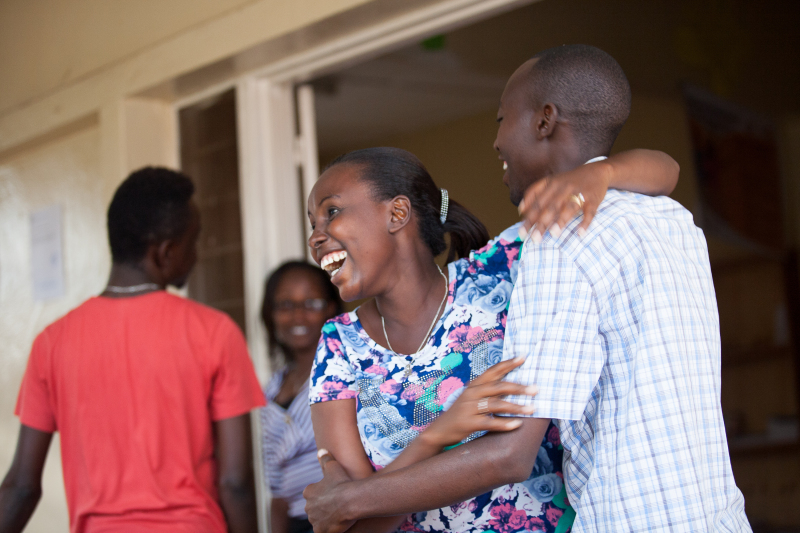Young people, in all their diversity, are central to the HIV response
 © Luisa Orza for Frontline AIDS
© Luisa Orza for Frontline AIDS
This week, a supplement on the Link Up project is published in the Journal of Adolescent Health.
Luisa Orza is the Alliance’s Lead: HIV Technical (SRHR) & Georgina Caswell is the Alliance’s Lead: Programmes
This week, a Journal of Adolescent Health supplement “Integrating Rights into HIV and Sexual and Reproductive Health: Evidence and experiences from the Link Up Project” is published. It brings together key learnings and reflections on the importance of recognising and engaging with diversity among young people in terms of age, gender, HIV status, and social circumstances, as well as country contexts.
Link Up (2013-2016) has enabled young people most impacted by HIV to make healthier choices regarding their sexuality, and to advocate for their sexual and reproductive health and rights (SRHR). It has also deepened knowledge, understanding and practice models that aid SRHR-HIV integration for young people – especially young people living with HIV and from key affected populations.*
What we loved about Link Up was how the project was for, with and by young people most impacted by HIV. As one young woman commented during a youth consultation held right at the beginning of the project, “No-one can have a better voice than youth themselves. They are the ones who know their issues and ways to deal with them.” This consultation helped to make sure that the project responded to the lived experiences of young people living with and most affected by HIV in all their diversity.
Young people led dialogues in the five Link Up countries (Bangladesh, Burundi, Ethiopia, Myanmar and Uganda) in different peer groups, and came up with a five-point framework for upholding, protecting and respecting the SRHR of all young people. These dialogues were also safe spaces for young people who were sometimes isolated, to come together and share their experiences.
For example, young mothers living with HIV said they often felt apart from other young women because they were already mothers; at the same time they felt they had no voice within networks of women living with HIV, because they were younger than most members. We learnt so much from this consultation about what young people really need, and their own visions for a world that responds to those needs.
What we loved about Link Up was how the project was for, with and by young people most impacted by HIV
Link Up worked with networks and organisations that were led by young people from the get-go, and these partners brought a lot of energy and ideas to the project. As the project went on, more and more resources were put into developing youth leadership, and these emerging leaders took on roles of increasing responsibility across the project. A fantastic example of this is a Youth Centre in Bujumbura, Burundi – which was an exemplary model of youth-led service delivery.
The diversity of the young people involved in Link Up was really exciting, and a core strength of the project. Understanding the different – and overlapping – vulnerabilities and needs of these often hidden groups has been an important outcome of the project. Link Up provided a space for young people to come together as young people across areas of diversity to advocate for SRHR for all young people most affected by HIV, recognising both the commonalities they share and the different needs among this group.
Similarly, Link Up provided an opportunity to work with younger adolescents in the 10-14 age range, for whom there is a dearth of integrated SRHR-HIV programming. This is despite the heavy toll that HIV-related mortality is having on this group. The project explored how critical it is to begin to engage young adolescents on areas like gender norms and sexuality in a safe environment, with age-appropriate service and information.

Fabien and Nadia of RNJ+, the young people’s positive network in Burundi. © Frontline AIDS
The diversity of the young people involved in Link Up was really exciting, and a core strength of the project
Link Up has used a range of strategies to put SRHR-HIV integration at its forefront. Peer outreach has been a central pillar to building trust among communities that are often marginalised, and creating bridges between these communities and the health facilities that service them, leading to greater service uptake among this vulnerable group. The project has also worked hard at transforming healthcare provider attitudes, ensuring services are friendly, non-judgmental, and tailored to the needs and evolving capacities of young people.
Through its operational research arm, documentation and evaluation the project has also revealed rich insights into working effectively with young people, useful for anyone seeking to meaningfully engage this generation and to unleash their potential.
* Key affected populations of young people in Link Up are defined as young people who sell sex, young men who have sex with men, young transgender people, and young people who use drugs, as well as other young people in country-specific contexts of vulnerability.
This article was written as the International HIV/AIDS Alliance, before we changed our name to Frontline AIDS.
Tags
Link UpSexual and reproductive health and rights (SRHR)Young people


